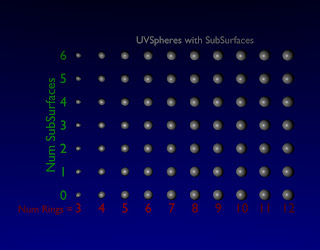This is a shell that will be expended in the future. It simplifies the problem of setting up an image in Blender. Other postings will build examples on top of this module.
For now, it is recommended to place this file in C:\tmp. I'll use that location in example scripts. A future release will have a more permanent recommended home.
Code:
Download Code for the Origami Library 0.001.
This file can be placed arbitrarily. Any script which imports this module must reference it by the full path because of how Blender handles files.
#!BPY
__doc__ = """
OLib_xxxx.py
Rev 0.001
This module setups up a scene for static rendering, animation or game engine operation
This module provides useful library functions.
This module does nothing from the Blender command line
------------------
History:
rev 0.001 8/2/2009
Initial release to test structure and functionality
edt
"""
__author__ = "edt"
__version__ = "0.001 2009/08/03"
__url__="Website, dataOrigami.blogspot.com"
##############################################################
__doc__ = """
This module setups up a scene for static rendering, animation or game engine operation
This module imports useful library functions.
rev 0.001
Initial release to test structure and functionality
edt 8/2/2009
"""
import Blender
import Blender.Mathutils
from Blender.Mathutils import *
class Image(object):
def __init__(self,name='Scene'):
# create new scene
scene = Blender.Scene.New(name)
scene.makeCurrent()
##############################################################
# add a camera and set it up
#
camdata = Blender.Camera.New()
cam = scene.objects.new(camdata)
# use setLocation to control the position of the camera
scene.objects.camera = cam
self.cam = cam
self._lookAt_x = 0
self._lookAt_y = 0
self._lookAt_z = 0
self.lookFrom(2.481,-1.508,1.1)
##############################################################
# add a lamp and set it up
#
lampData = Blender.Lamp.New()
lampData.setEnergy(1.0)
lampData.setType('Lamp')
lampData.mode |= Blender.Lamp.Modes["RayShadow"] # make shadows appear
lamp = scene.objects.new(lampData)
lamp.setLocation(2.0,2.0,5.0)
lamp.setEuler(120*(3.1415/180),30*(3.1415/180),-30*(3.1415/180))
#
################################################################
# setup world
world = Blender.World.New(name+'_World')
world.setCurrent()
self.scene = scene
self.lamp = lamp
self.world = world
def lookFrom(self,*args):
if len(args)==1:
# we have an object which contains look information
x = args[0].x
y = args[0].y
z = args[0].z
elif len(args)==3:
# we have x,y,z coordinates
x = args[0]
y = args[1]
z = args[2]
# set camera position to x,y,z
self.cam.setLocation(x,y,z)
self.lookAt()
def lookAt(self,*args):
if len(args)==0:
to_x = self._lookAt_x
to_y = self._lookAt_y
to_z = self._lookAt_z
up_x = 0
up_y = 1
up_z = 0
elif len(args)==1:
# we have an object which contains look information
to_x = args[0].x
to_y = args[0].y
to_z = args[0].z
up_x = 0
up_y = 1
up_z = 0
elif len(args)==2:
# we have an object which contains look information
to_x = args[0].x
to_y = args[0].y
to_z = args[0].z
up_x = args[1].x
up_y = args[1].y
up_z = args[1].z
elif len(args)==3:
# we have x,y,z coordinates
to_x = args[0]
to_y = args[1]
to_z = args[2]
up_x = 0
up_y = 1
up_z = 0
elif len(args)==6:
# we have x,y,z coordinates
to_x = args[0]
to_y = args[1]
to_z = args[2]
up_x = args[3]
up_y = args[4]
up_z = args[5]
# save view target
self._lookAt_x = to_x
self._lookAt_y = to_y
self._lookAt_z = to_z
# set camera position to x,y,z
from_x, from_y, from_z = self.cam.getLocation()
p1 = Vector([from_x,from_y,from_z])
p2 = Vector([to_x,to_y,to_z])
# form a vector that points in the direction from p1 to p2
dir = p2-p1
#print 'from='+str(p1)
#print 'to='+str(p2)
#print 'dir='+str(dir)
dir.normalize()
#u = dir
up = Vector([up_x,up_y,up_z])
up.normalize()
dir_ref = Vector([0,0,-1.0]) # direction the camera naturally points w/o rotation
if True: #abs(AngleBetweenVecs(dir,dir_ref))>1e-6:
d = -dir
e = up-up*DotVecs(dir,up)
e.normalize()
f = -CrossVecs(d,e)
A = Matrix(
[f[0],f[1],f[2],0],
[e[0],e[1],e[2],0],
[d[0],d[1],d[2],0],
[from_x,from_y,from_z,1])
else:
# the direction of view is parallel to the z-axis
A = Matrix(
[1,0,0,0],
[0,1,0,0],
[0,0,1,0],
[from_x,from_y,from_z,1])
# apply the transform to the camera
self.cam.setMatrix(A)
def add(self,item,name='noName'):
# this method allows any object to be added to the scene
ob = self.scene.objects.new(item,name)
return ob
def delete(self,item):
self.scene.objects.unlink(item)
def addSphere(self,**kwargs):
# default the values
diameter = kwargs.get('diameter',1.0)
segments = kwargs.get('segments',8)
rings = kwargs.get('rings',8)
loc = kwargs.get('location',[0,0,0])
useIco = kwargs.get('useIco',False)
useUV = kwargs.get('useUV',True)
subdivisions = kwargs.get('subdivisions',2)
name = kwargs.get('name','sphere')
if useIco:
sphere = Blender.Mesh.Primitives.Icosphere(subdivisions,diameter)
else:
sphere = Blender.Mesh.Primitives.UVsphere(segments,rings,diameter)
ob = self.add(sphere,name)
ob.setLocation(loc)
return ob
def addCube(self,*kwargs):
pass
def addCylinder(self,**kwargs):
pass
def addPlane(self,**kwargs):
pass
def addText(self,**kwargs):
loc = kwargs.get('location',[0,0,0])
name = kwargs.get('name','sphere')
txtStr= kwargs.get('text','Default Message')
width = kwargs.get('width',1.0)
height= kwargs.get('height',1.0)
col = kwargs.get('color',[1.0,1.0,1.0])
align = kwargs.get('align','LEFT')
txt = Blender.Text3d.New()
txt.setText(txtStr)
txt.setSize(0.1)
alignDict = {'LEFT':Blender.Text3d.LEFT,'RIGHT':Blender.Text3d.RIGHT,
'MIDDLE':Blender.Text3d.MIDDLE, 'FLUSH':Blender.Text3d.FLUSH}
txt.setAlignment(alignDict[align])
mat=Blender.Material.New('textMat')
mat.rgbCol = col
ob = self.add(txt)
me = Blender.Mesh.New('textMesh')
me.getFromObject(ob)
me.materials += [mat]
self.delete(ob)
newOb = self.add(me,name)
# force a redraw to ensure that the bounding box is updated!!
Blender.Window.RedrawAll()
boundBox = newOb.getBoundBox(1)
upperBox = max(boundBox)
lowerBox = min(boundBox)
initialWidth = upperBox[0]-lowerBox[0]
initialHeight = upperBox[1]-lowerBox[1]
widthRatio = width/initialWidth
heightRatio = height/initialHeight
ratio = min(widthRatio,heightRatio)
newOb.setSize(ratio,ratio,ratio)
newOb.setLocation(loc)
return newOb
def addWorld(self,**kwargs):
pass
def drawNow(self,**kwargs):
xSize = kwargs.get('xSize',1024)
ySize = kwargs.get('ySize',800)
overSampleLevel = kwargs.get('oversamplingLevel',16)
#print 'Image.drawNow() executing'
self.context = self.scene.getRenderingContext()
# enable seperate window for rendering
Blender.Scene.Render.EnableDispWin()
self.context.imageType = Blender.Scene.Render.JPEG
if overSampleLevel>0:
self.context.enableOversampling(True)
self.context.setOversamplingLevel(overSampleLevel)
else:
self.context.enableOversampling(False)
self.context.imageSizeX(xSize)
self.context.imageSizeY(ySize)
# draw the image
self.context.render()
def save(self,filename='image.jpg'):
self.drawNow()
self.context.saveRenderedImage(filename)
class Animation(object):
pass
class BEG(object):
pass
# This does not work with Blender
#if name=='__main__':
# # test/demo codes here
# pass
To copy the code snippets easily, see:http://dataorigami.blogspot.com/2009/06/how-to-easily-copy-code-snippets-from.html
To execute the script in Blender, see:http://dataorigami.blogspot.com/2009/06/how-to-execute-script-from-command-line.html
To work with the script in a simple IDE, see:http://dataorigami.blogspot.com/2009/04/developing-scripts-for-blender.html






